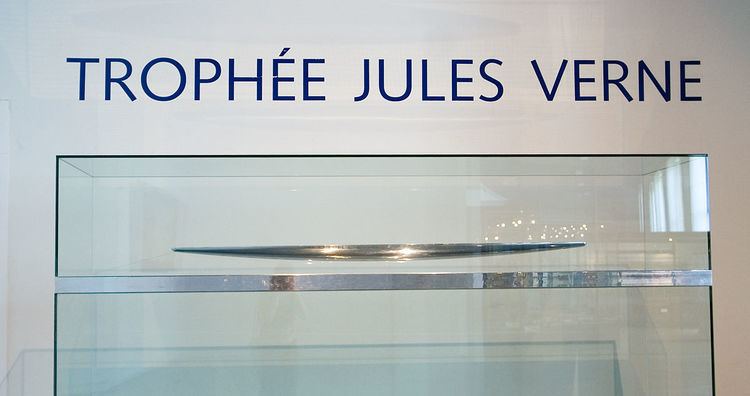 | ||
The Jules Verne Trophy is a prize for the fastest circumnavigation of the world by any type of yacht with no restrictions on the size of the crew provided the vessel has registered with the organization and paid an entry fee. A vessel holding the Jules Verne trophy will not necessarily hold the absolute round the world record. The trophy was first awarded to the first yacht which sailed around the world in less than 80 days. The name of the award is a reference to the Jules Verne novel Around the World in Eighty Days in which Phileas Fogg traverses the planet (albeit by railroad and steamboat) in 80 days. The current holder is IDEC Sport skippered by Francis Joyon in 40 days 23 hours 30 minutes 30 seconds.
Contents
Route
Rules
History
The original idea for this competition has been attributed to Yves Le Cornec in 1985. The rules were defined in 1990. A committee was put in place to guarantee respect of the rules and fairplay. This committee included Peter Blake, Florence Arthaud, Jean François Coste, Yvon Fauconnier, Gabrie Guilly, Robin Knox-Johnston, Titouan Lamazou, Yves Le Cornec, Bruno Peyron, Olivier de Kersauson, and Didier Ragot.
While the current holder of the trophy, Francis Joyon, also holds the around the world sailing record, this has not always been the case. In 2004 Steve Fossett broke the world record with the catamaran Cheyenne but was not awarded the trophy. According to reports, the trophy organizers requested a higher entrance fee from Fossett than from the other competitors, the difference which he refused to pay. The winner of the trophy that year was Olivier de Kersauson on Geronimo, with a time which was five days slower than Fossett's world record.
The Trophy
The "Trophy Jules Verne" was the subject of a public order of the visual arts delegation with the American artist Thomas Shannon and is patroned by the French Ministry of Culture.
The work is a floating hull on a magnetic field, much as an anchorage for a ship. All dimensions have rigorous symbolic meaning. The midship beam of the hull corresponds to the diameter of the Earth, the ray of each end is proportional to that of the moon and the radius of the curvature of the frames is that of the sun. The competitors of the Trophy Jules Verne race around the Earth against time, with only the sun and the moon as companions and time keepers.
The sculpture is placed on a cast aluminium base, on which the names of the sailors having won the Trophy are engraved. The Musée national de la Marine in Paris hosts and maintains the Trophy. Each winner receives a miniature of the Trophy, magnetized like the original one.
When a record is broken, an official ceremony is held for the previous record holders to hand over the trophy to the new record holders, who are given the hull and must place it in its magnetic field mooring.
